More photographs are available on our history page. Thanks Sharky.
| Very few photographers manage to capture the power that is produced by a Sportsman Dragster. Whilst Top Alchohol and Top Fuel cars (3000 and 6000 bhp) cars are seen putting out an enormous amount of unburnt fuel and dissipated energy, good photographs of sportsman cars are rare. Sharkman's show that they are making at least the power of a formula one car and some of them twice that! | |
| A lot of my favourite photographs are taken by Tom Ward A.K.A Sharkman. He understands that dragsters are different and manages to capture (for me anyway) the power and subtleties which they exhibit - especially on the start line. | |
| Here are a few favourites - with my comments - hope you find them interesting. | |
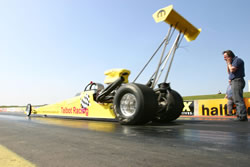 |
|
| Much of the work for the sportsman racer is done away from the track. While the pro teams can strip and rebuild their cars at the track, the sportsman racer usually has to do that work at home - in their own time. Here Rob Loaring (www.iceautomotive.co.uk) watches the engine he has just rebuilt for us whilst Pat launches during a private test day. Note the compression of the tyre is in the 'unwind' phase which shows that she is actually moving forwards. You can also see this in our 'wind' sock - the small bit of string on the rear wing strut. That's what it's there for! I'm relaxing(?) against the barrier (behind Rob) and the crowd of one sits in awe. . . . | |
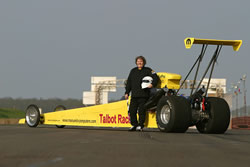 |
|
| I think this is a great photo. It shows the finish line gantry at Santa Pod in the background. It shows the hight and scale of the car from the rear. The back axle is based on a design originally put into the Ford Mustang in the early 60's - the gearbox is based on a Chevrolet design from the 50's. The Engine?- it's based on a Chrysler (of course) again from the mid 60's - only about 900 bhp more than standard. | |
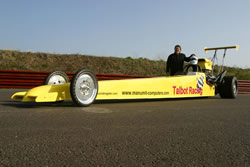 |
|
| Startline photo's always compress the car - most people ask me - how long is it? This photo is taken from the angle that most race cars are photographed from - front quarter. Now that's long. The front wheels - who most people call "tiny" are actually larger that a standard road car in diameter! | |
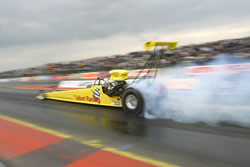 |
|
Cleaning the tyres. By the time the car has been towed around the track, sat in the tarmac pairing lanes and then fired up, the tyres are both dirty and cold. BURN OUT is how we clean them. Actually the car is in top gear and doing 7000 rpm in this picture. If the tyres did grip it would probably flip straight over. The driver is feathering the throttle at this stage to make sure she doesn't over-rev the engine.She's driving it in a straight line, often on full lock - expecting it to suddenly turn sharp left (or right) and keeping an eye on the gauges. Of course there's no real skill in drag racing. You just plant your foot down and go. If only. . . . |
|
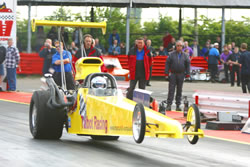 |
|
| Once the light goes green (which the driver shouldn't see) The car has 1400 bhp or so 'dropped' on the back axle. Pat is still convinced that the car only comes a couple of inches off the floor - even though she has seen this photograph a number of times. At this point the car is accelerating at 3.5 G and doing 0-60 in less than a second. It has about 1100 ft lb of torque on the tyres (which are bolted onto the rims) | |
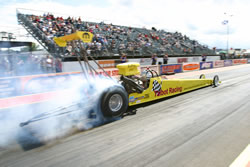 |
|
| More burn out. It's interesting that the track grip solution makes the track so sticky that a standard road car - 200 or 300 bhp would not be able to spin it's wheels at all at this part of the track. Indeed I have to tie my shoes laces extremely tightly to keep my shoes on as I walk in front of the car. The main difference between this photo and the other burn out one is that the car has 'grown' 2 metre long wheelie bars which stop the nose going too high in the launch. | |
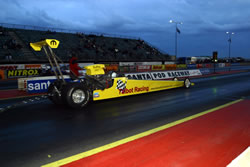 |
|
| A lovely night shot. The car has moved about three feet at this point and the rear tyres are fully 'unloaded' and are spinning slightly - you can see that in the writing on the side. They have not yet started to 'grow' which gives the effect of having an extra gear. The tyres can gain about 3 inches in diameter as they accelerate down the track. | |
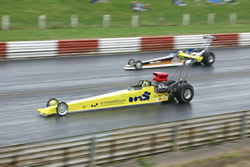 |
|
| Side by side but who is in the lead? Super Pro ET is a handicap class which means that the faster car leaves last. Therefore although Pat is in front here, Steve Johnson in the Motormouse car could be in the lead. As you can see in the following picture the driver can see very little behind. Of course we can also lose by going too fast as well - the skill is knowing where you opponent should be and where they actually are. It also shows the car at 'full throttle' with the tyres fully extended - in effect in ovedrive. | |
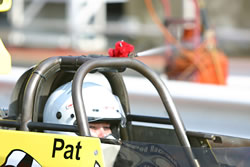 |
|
| Bully on the rollcage. Pat is approaching the startline. She has armed the nitrous system and is purging it - she can then tell it's armed and working correctly. It's not as effective a crowd pleaser as a huge plume of nitrous - but does work just as well. Within 10 seconds from this photograph Pat will be doing 190mph. | |